There’s something undeniably magnetic about French style—it whispers rather than shouts, suggests rather than demands, and somehow makes “I woke up like this” look utterly intentional.
French hairstyles embody this same philosophy, blending timeless elegance with an artfully undone quality that feels both aspirational and achievable.
Whether you’re drawn to the romantic waves of a Parisian café dweller or the sleek sophistication of a Riviera sunset, 27 Trendy French Hairstyles That Define Effortless Chic will guide you through the most coveted looks that capture the essence of French beauty.
This article unveils the secrets behind classic French twists, modern interpretations of vintage styles, and contemporary cuts that have taken the fashion world by storm.
From the iconic French bob to tousled braids that look like they were styled by the Mediterranean breeze itself, you’ll discover how to infuse your hair routine with that enviable je ne sais quoi that makes French style eternally relevant and endlessly inspiring.
Contents
- 1 1. The Classic French Bob
- 2 2. Tousled Beach Waves
- 3 3. The Low Chignon
- 4 4. Bardot Bangs
- 5 5. French Twist Updo
- 6 6. Messy Top Knot
- 7 7. Side-Swept Waves
- 8 8. The Parisian Ponytail
- 9 9. Loose Braided Crown
- 10 10. Textured Pixie Cut
- 11 11. Half-Up Half-Down Style
- 12 12. Slicked-Back Bun
- 13 13. Soft Layered Cut
- 14 14. Twisted Low Bun
- 15 15. Long Center Part
- 16 16. Braided Side Ponytail
- 17 17. Wispy Fringe
- 18 18. Rolled Edges Bob
- 19 19. Loose Fishtail Braid
- 20 20. Tucked Behind Ears
- 21 21. Voluminous Blowout
- 22 22. Scarf-Wrapped Ponytail
- 23 23. Barely-There Highlights
- 24 24. Pinned Back Waves
- 25 25. Graduated Bob with Movement
- 26 26. Natural Texture Embrace
- 27 27. Elegant Low Waves
1. The Classic French Bob
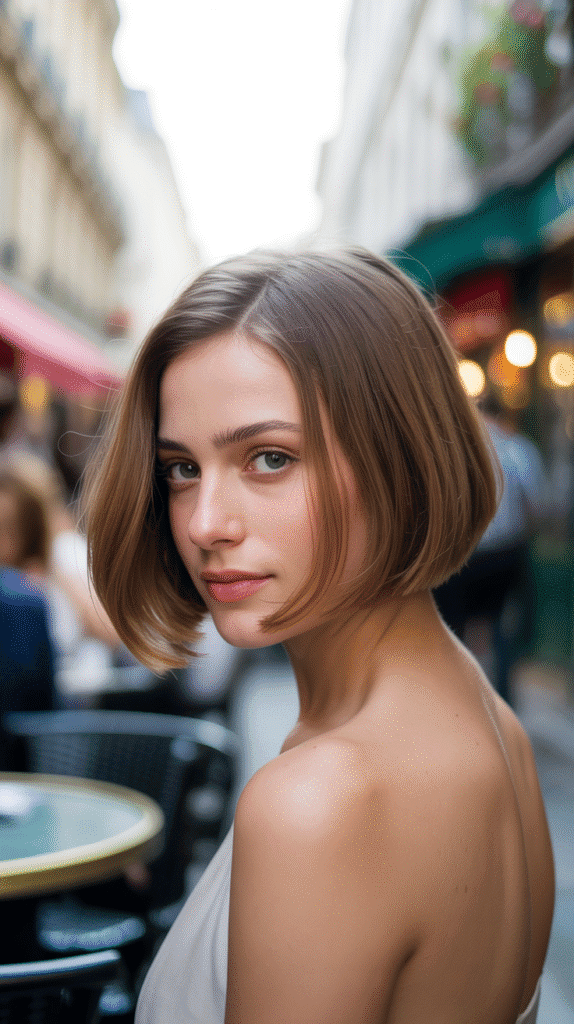
The French bob represents the cornerstone of Parisian hair culture, a cut that has transcended generations while maintaining its reputation as the ultimate statement of confident simplicity.
This timeless style sits typically between the chin and jawline, featuring blunt ends that create a striking frame for the face while maintaining enough movement to avoid appearing severe or rigid.
- The classic French bob works by creating a sharp horizontal line that emphasizes facial structure, particularly the jawline and cheekbones, making it universally flattering across different face shapes.
- This cut requires minimal styling—most French women simply let their bob air-dry with a touch of texturizing spray, embracing natural texture rather than fighting against it.
- The blunt ends distinguish the French bob from other bob variations, providing a deliberate edge that communicates intentionality without appearing overly styled or contrived.
- Regular trims every six to eight weeks maintain the precision of the cut, ensuring the blunt line remains sharp and the overall shape stays true to its architectural design.
- For styling versatility, the French bob can be worn straight for a polished look, gently waved for romantic occasions, or deliberately tousled for that coveted undone aesthetic.
2. Tousled Beach Waves
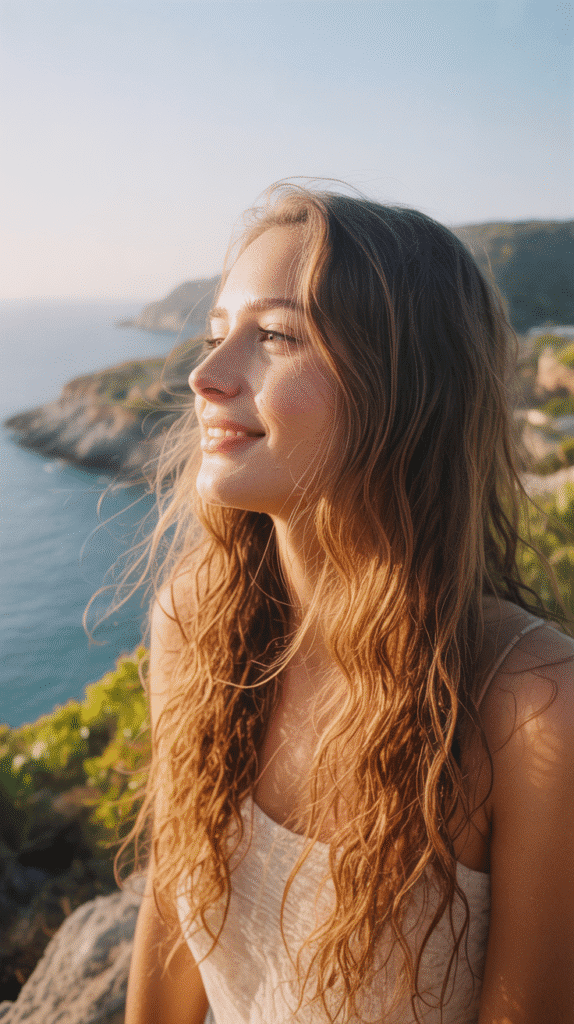
Tousled beach waves capture the essence of French coastal living, evoking images of windswept hair after a day spent along the Côte d’Azur.
This effortlessly textured style celebrates natural movement and imperfection, creating dimension through loose, irregular waves that appear entirely unconstructed.
- Beach waves succeed by creating multiple directions of wave patterns throughout the hair, avoiding the uniform appearance of traditional curling methods that can look overly manufactured.
- The French approach involves enhancing natural texture rather than creating it from scratch, using sea salt spray on damp hair and scrunching gently while air-drying.
- For those with naturally straight hair, wrapping random sections around a large-barrel curling iron for just seconds creates irregular waves that mimic natural texture.
- The key distinguishing factor lies in the roots—French beach waves maintain relatively smooth roots with texture concentrated from mid-lengths to ends, preventing the style from appearing messy.
- This versatile look transitions seamlessly from casual daytime activities to evening events, requiring nothing more than a quick finger-comb to refresh and reshape.
- According to hair texture experts at Byrdie, achieving authentic-looking beach waves depends more on technique than products, emphasizing the importance of irregular sectioning and varied curl directions.
3. The Low Chignon
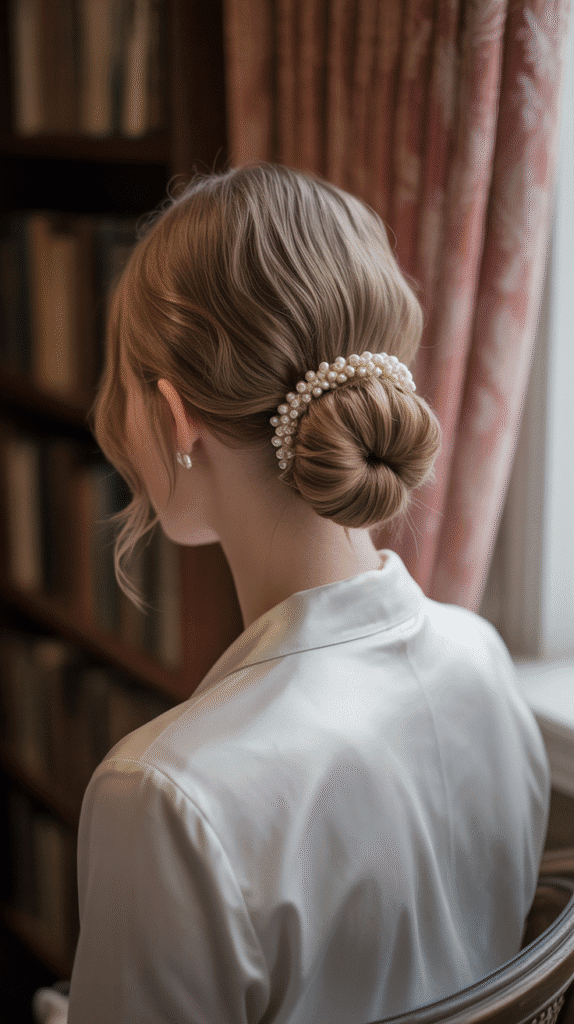
The low chignon exemplifies French formal hairstyling, offering a sophisticated updo that manages to appear both polished and relaxed simultaneously.
Positioned at the nape of the neck, this gathered style pulls hair into a soft, rounded shape that avoids the severity of traditional buns while maintaining complete elegance.
- The construction begins with gathering hair into a low ponytail, then twisting the length loosely before wrapping it around the base and securing with pins strategically hidden within the folds.
- French chignons deliberately incorporate slight imperfection—a few face-framing pieces left loose, subtle texture throughout the gathered hair, and a softly rounded rather than tightly controlled silhouette.
- This updo works particularly well for medium to thick hair textures, as the volume creates the characteristic rounded shape naturally without requiring excessive backcombing or padding.
- Strategic pin placement ensures security without rigidity, with pins inserted horizontally through the twisted hair rather than straight down into the scalp, allowing slight movement.
- The low positioning creates an elongating effect on the neck while maintaining versatility for various necklines, from high collars to plunging backs.
- For added security during extended wear, incorporating a light hairspray after completing the style helps maintain structure while preserving the soft, touchable quality.
4. Bardot Bangs
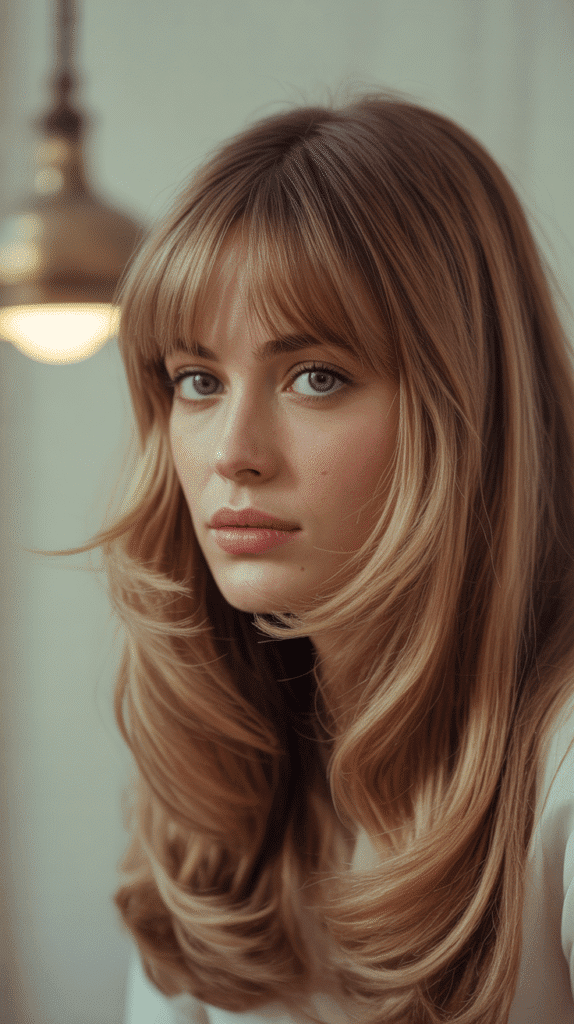
Bardot bangs immortalize the signature style of French icon Brigitte Bardot, featuring curtain-style fringe that parts down the center and sweeps elegantly to each side of the face.
This face-framing approach to bangs creates a softening effect while maintaining an unmistakably retro-chic appeal that has experienced numerous revivals.
- The defining characteristic involves cutting the bangs longer at the outer edges, creating a gradual length transition that allows the fringe to blend seamlessly into the rest of the hair.
- Bardot bangs require a center part as their foundation, with the shortest point of the fringe typically hitting at the bridge of the nose or slightly below, providing enough length to sweep gracefully aside.
- Styling involves blow-drying the bangs away from the face using a round brush, creating volume at the roots while directing the ends outward in a gentle curve.
- This bang style proves remarkably forgiving during the growing-out phase, as the graduated length maintains its face-framing shape even as it lengthens, unlike blunt bangs that require frequent trims.
- The curtain effect creates a widening appearance at the cheekbones while drawing attention to the eyes, making this style particularly flattering for those with narrower forehead widths.
- Maintenance requires minimal commitment compared to other bang styles, typically needing only a trim every six to eight weeks to maintain the optimal length and shape.
5. French Twist Updo
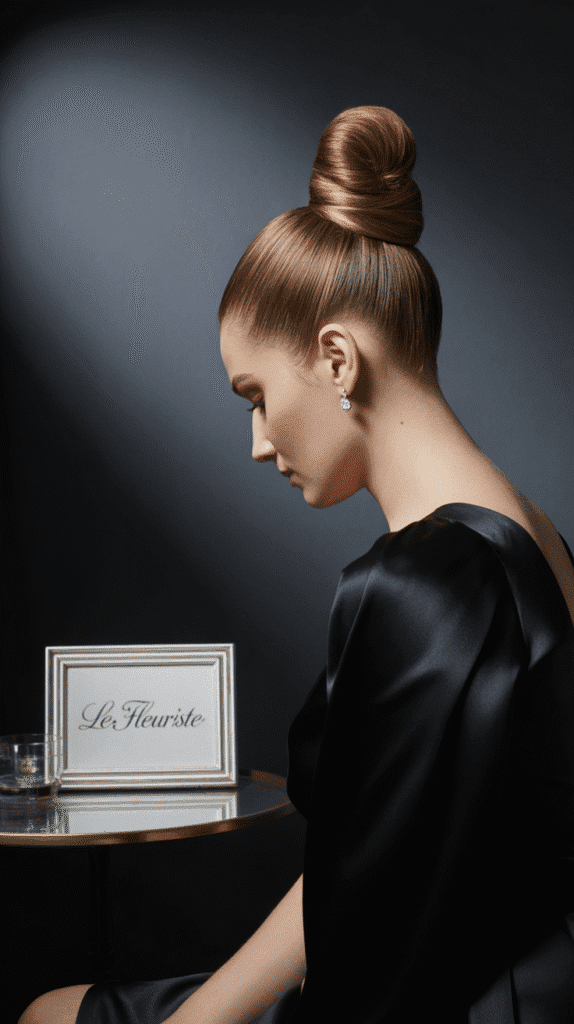
The French twist updo stands as perhaps the most iconic formal French hairstyle, creating vertical elegance through a sophisticated rolling technique that gathers hair into a sleek column along the back of the head.
This timeless style communicates refinement and grace while showcasing the neck and shoulders beautifully.
- Creating an authentic French twist begins with smoothing hair back from the face and gathering it loosely at the center back of the head, then twisting the length vertically while simultaneously folding it inward.
- The rolled section should sit vertically along the center back rather than to one side, creating a clean, architectural line that serves as the style’s signature element.
- Strategic pin placement proves crucial—pins should be inserted horizontally into the rolled section, angling slightly downward to catch the hair beneath and create lasting hold.
- For added security and smoothness, applying a light gel or smoothing cream before twisting helps control flyaways and creates the characteristic sleek finish.
- The French twist works beautifully for various hair lengths, though shoulder-length or longer hair typically provides enough weight to create the substantial rolled effect.
- Modern interpretations sometimes incorporate slight volume at the crown or leave a few face-framing pieces loose, softening the traditional severity while maintaining the style’s essential structure.
6. Messy Top Knot
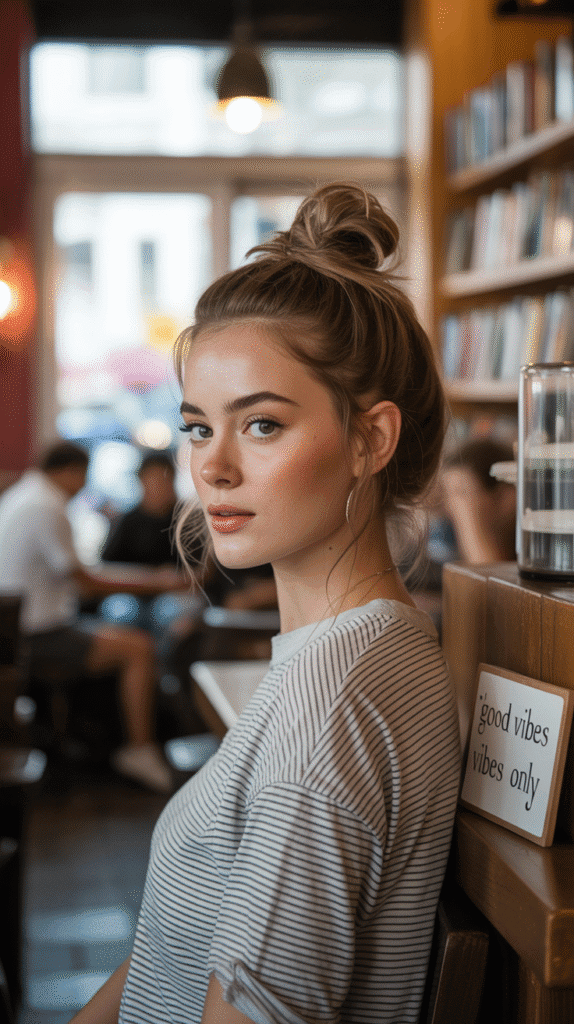
The messy top knot epitomizes the French casual-chic aesthetic, positioning a deliberately imperfect bun high on the crown to create an effortlessly stylish look that appears thrown together in seconds.
This go-to style communicates confident nonchalance while keeping hair completely secured and off the face.
- The positioning makes all the difference—a true French top knot sits at the crown rather than the very top of the head, creating a more natural, less severe appearance.
- Construction involves gathering hair into a high ponytail, then twisting the length loosely only once or twice before wrapping it around the base in an irregular pattern that embraces rather than hides imperfection.
- The securing technique uses a single hair tie for the initial ponytail, then bobby pins to tack the wrapped hair in place, inserting pins in various directions for security without over-controlling the shape.
- Deliberately pulling out face-framing pieces before securing the knot creates the signature undone quality, with these loose sections appearing intentional rather than accidental.
- Volume at the bun itself comes from not twisting the hair too tightly, allowing the natural thickness to create fullness rather than relying on teasing or added padding.
- This style transitions seamlessly from workout to workday to evening drinks, requiring only a quick smoothing of flyaways and perhaps a touch of dry shampoo at the roots for refreshment.
7. Side-Swept Waves
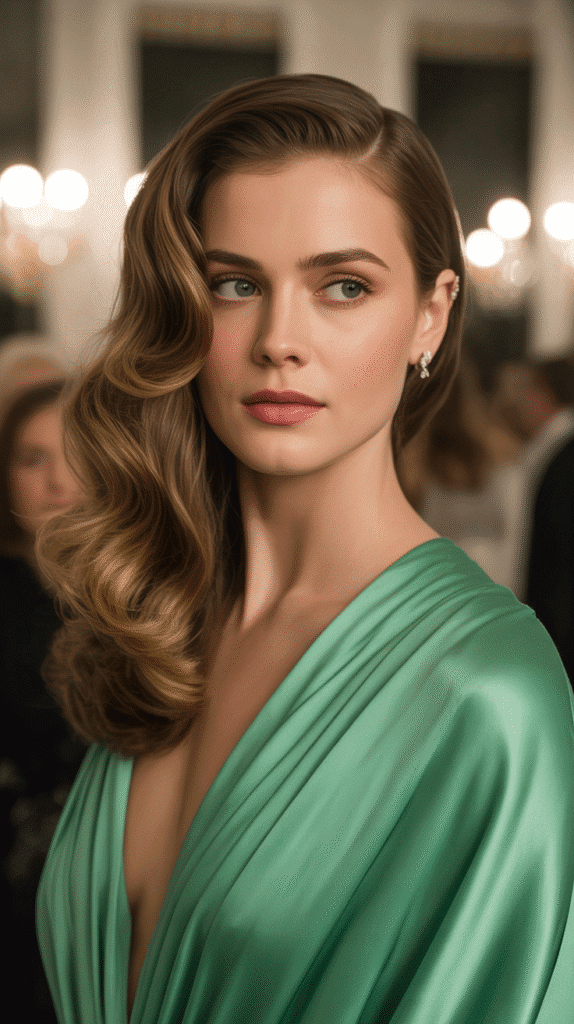
Side-swept waves combine classic Hollywood glamour with French subtlety, creating a romantic look where soft waves cascade over one shoulder while the opposite side remains sleek and tucked.
This asymmetrical approach adds drama without overwhelming natural beauty or appearing too constructed.
- The foundation begins with creating a deep side part, typically positioned above the outer edge of one eyebrow, which establishes the dramatic asymmetry that defines this style.
- Waves should be created using a large-barrel curling iron or hot rollers, focusing primarily on the hair that will drape over the shoulder while keeping the tucked side relatively smooth.
- The tucked side requires strategic pinning behind the ear, with bobby pins inserted horizontally and hidden within the hair’s natural contours to maintain security without visible hardware.
- For lasting hold on the draped side, each curl should be allowed to cool completely in its curled shape before being gently loosened, creating waves that maintain their structure throughout extended wear.
- The French interpretation keeps waves soft and touchable rather than stiff or overly defined, achieved by running fingers through cooled curls gently rather than brushing them.
- A light finishing spray applied from a distance provides hold without creating crunchiness, maintaining the hair’s natural movement and softness to the touch.
8. The Parisian Ponytail
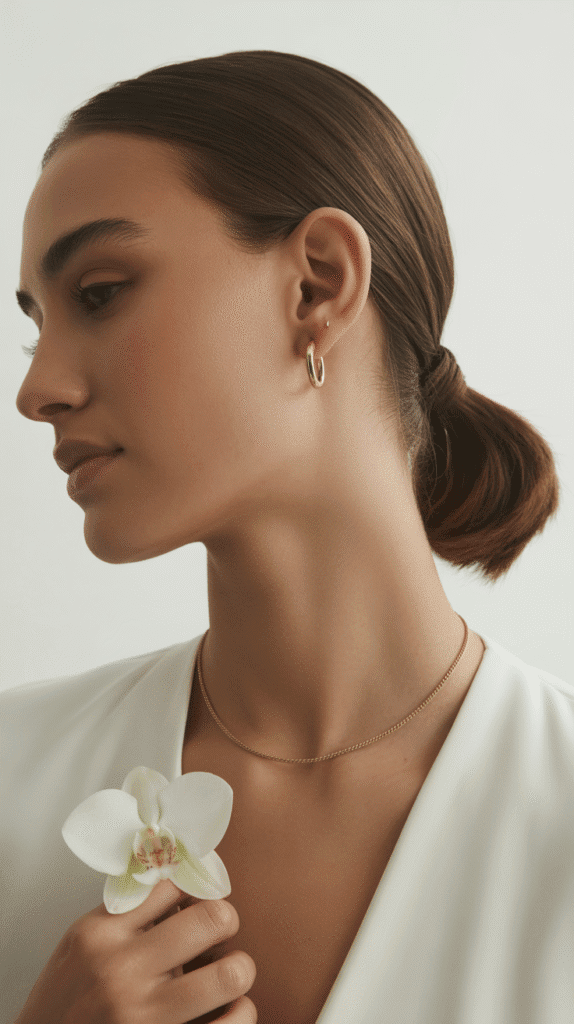
The Parisian ponytail elevates the everyday basic into something unexpectedly chic through subtle refinements in positioning, texture, and finishing.
This deceptively simple style demonstrates how French beauty philosophy transforms utilitarian elements into expressions of personal style.
- The positioning typically sits low at the nape of the neck rather than high on the crown, creating an understated elegance that differs markedly from athletic or casual high ponytails.
- The hallmark involves maintaining smoothness through the top and sides while allowing the ponytail itself to have natural texture and movement, creating an interesting contrast between controlled and relaxed elements.
- Wrapping a small section of hair around the elastic conceals the hair tie while adding a polished finishing touch that distinguishes this from more casual ponytail variations.
- French ponytails often incorporate a slight volume boost at the crown, achieved by gently lifting the hair at the roots after securing the ponytail rather than through aggressive backcombing.
- The length of the ponytail displays deliberate texture—whether natural waves, subtle bends, or gentle curls—never pin-straight, which would appear too severe and controlled.
- Strategic application of shine serum on the smooth section contrasts with texturizing spray on the ponytail length, emphasizing the intentional difference between the style’s controlled and relaxed components.
9. Loose Braided Crown
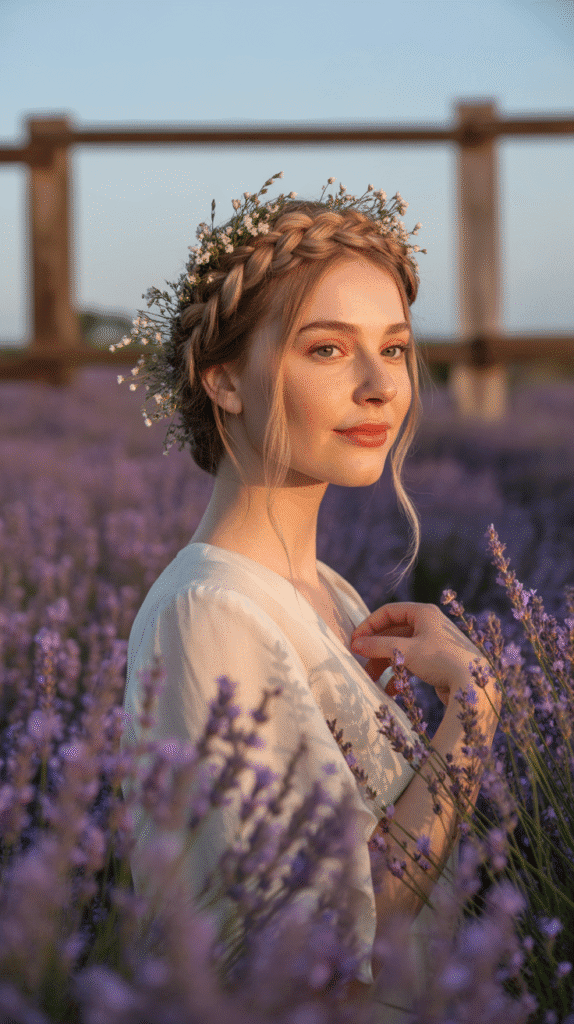
The loose braided crown creates a romantic halo effect by wrapping a softly braided section across the top of the head from ear to ear.
This delicate style evokes pastoral French countryside aesthetics while providing practical hair control that doesn’t sacrifice femininity or softness.
- Construction begins by sectioning off hair from temple to temple across the top of the head, leaving the remaining hair loose and flowing to maintain the style’s airy, romantic quality.
- The braid itself should be created loosely, with deliberate imperfection and gentle tension that allows the braid to spread slightly, creating a wider, more delicate appearance than standard tight braiding.
- After completing the braid, gently pulling apart the sections—”pancaking” the braid—increases width and creates a softer, more dimensional appearance that better suits the romantic aesthetic.
- The braid typically secures behind one or both ears with small bobby pins hidden within the plaits, allowing the remaining loose hair to cascade naturally.
- This style works beautifully for various hair textures, though naturally wavy or curly hair creates particularly ethereal results as the loose hair provides organic movement and volume.
- For special occasions, tiny flowers, delicate ribbon, or pearl pins woven into the braid enhance the romantic quality without overwhelming the style’s inherent delicacy.
10. Textured Pixie Cut
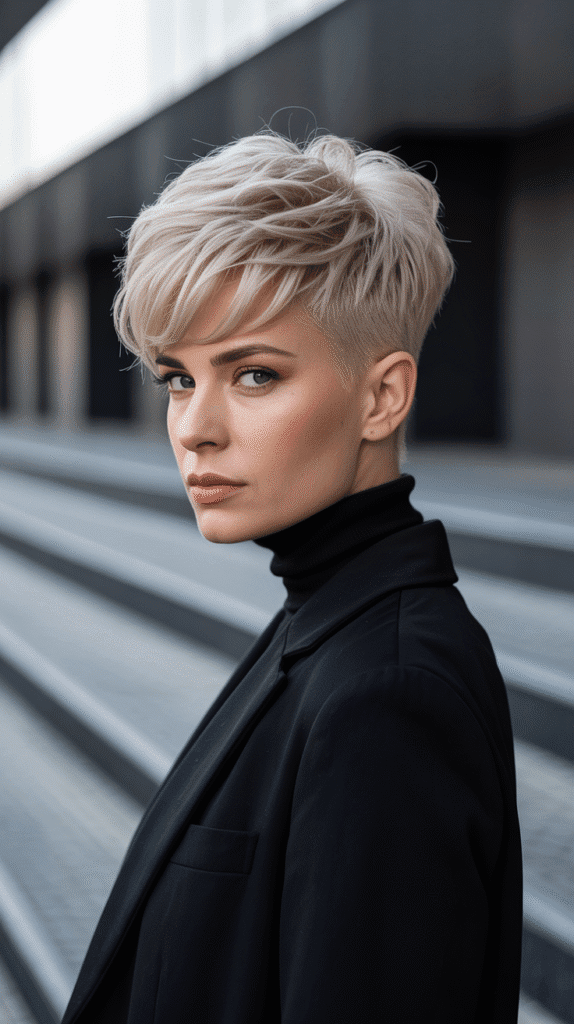
The textured pixie cut represents French hairstyling at its most daring and modern, combining closely cropped sides with longer, piece-y top sections that create dimension and movement.
This contemporary short style communicates confidence and modernity while maintaining the French commitment to effortless styling.
- The defining characteristic involves length variation throughout, with the sides and back cut short while the top section maintains enough length for styling versatility and texture.
- Styling relies heavily on texturizing products applied to damp hair and worked through with fingers rather than brushes, creating separation and definition between individual pieces.
- The French approach to pixie styling embraces natural growth patterns and hair direction rather than fighting against them, allowing crowns to have lift and hairlines to follow their natural flow.
- This cut requires regular maintenance every four to six weeks to maintain the shape and proportion between the shorter and longer sections, preventing the style from appearing grown-out rather than intentional.
- The textured top can be styled in multiple directions—swept forward for edge, pushed back for sophistication, or tousled for casual appeal—making this a remarkably versatile short style.
- Color techniques like highlights or balayage add additional dimension to pixie cuts, emphasizing the texture and movement while creating depth that prevents the short length from appearing flat.
11. Half-Up Half-Down Style
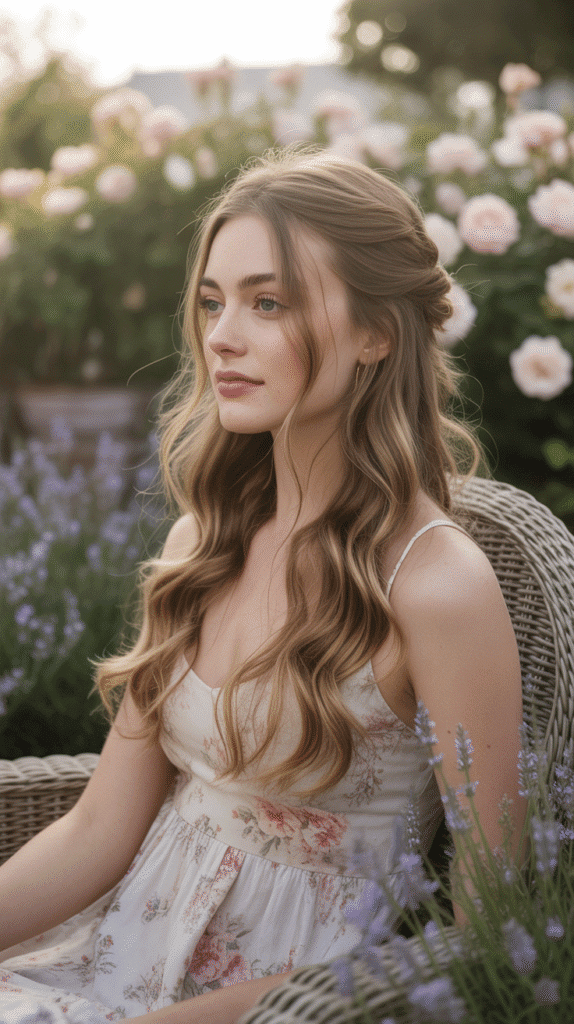
The half-up half-down style achieves perfect balance between secured and flowing hair, pulling the top section away from the face while allowing the remaining length to cascade freely.
This versatile approach works for virtually any occasion, from casual daily wear to formal events, depending on finishing details and hair texture.
- The French interpretation typically secures less hair than standard half-up styles, taking only a small section from the temples to the crown and leaving maximum volume and movement in the lower section.
- The secured portion can be finished various ways—a simple twist, a small low bun, or secured directly with an elegant barrette or clip—with the choice depending on the desired level of formality.
- Maintaining volume at the crown proves essential, achieved by gently backcombing at the roots of the secured section before pulling it back, creating lift without obvious teasing.
- The transition between secured and loose hair should appear seamless rather than creating a visible line or indent, accomplished by securing gently and allowing pieces to blend naturally.
- This style works beautifully with various hair textures, though adding waves or curls to the loose section creates particularly romantic results that enhance movement and dimension.
- For formal occasions, the secured section can incorporate braiding or twisting techniques, while casual versions might simply gather hair with a minimalist hair tie or elegant claw clip.
12. Slicked-Back Bun
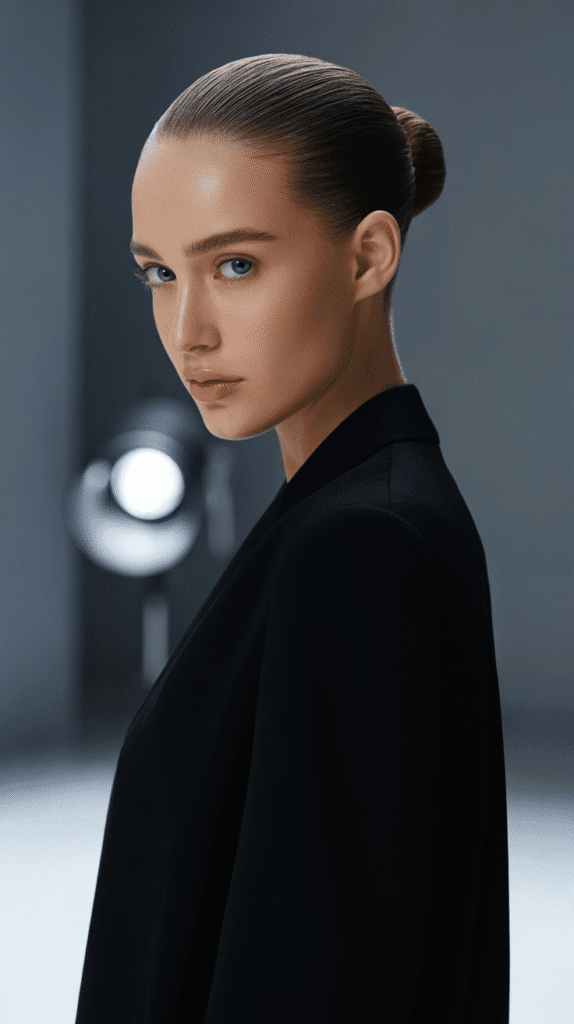
The slicked-back bun projects powerful sophistication through its dramatic smoothness and precise execution, pulling hair back tightly from the face before securing it in a controlled bun at the crown or nape.
This bold style makes an undeniable statement while showcasing facial features with complete clarity.
- Creating the signature sleekness requires applying gel or pomade to damp hair, then using a fine-tooth comb to smooth hair back from the hairline with precision that eliminates any bumps or irregularities.
- The bun itself can vary in size and position—a larger, looser bun creates softer impact while a small, tight bun communicates severe elegance and maximizes the sleek effect.
- Strategic bobby pin placement around the bun’s perimeter keeps every hair in place, with pins inserted at angles that create maximum hold while remaining completely hidden within the style.
- This look requires hair products that provide strong hold without flaking, as the smooth finish is the style’s defining feature and any product residue would compromise the sleek appearance.
- A defining hairline with gel and a small brush creates sharp precision at the edges, emphasizing the intentional, controlled nature of the style.
- For lasting hold throughout extended wear, a final mist of strong-hold hairspray over the smoothed sections locks everything in place while maintaining the characteristic shine.
13. Soft Layered Cut
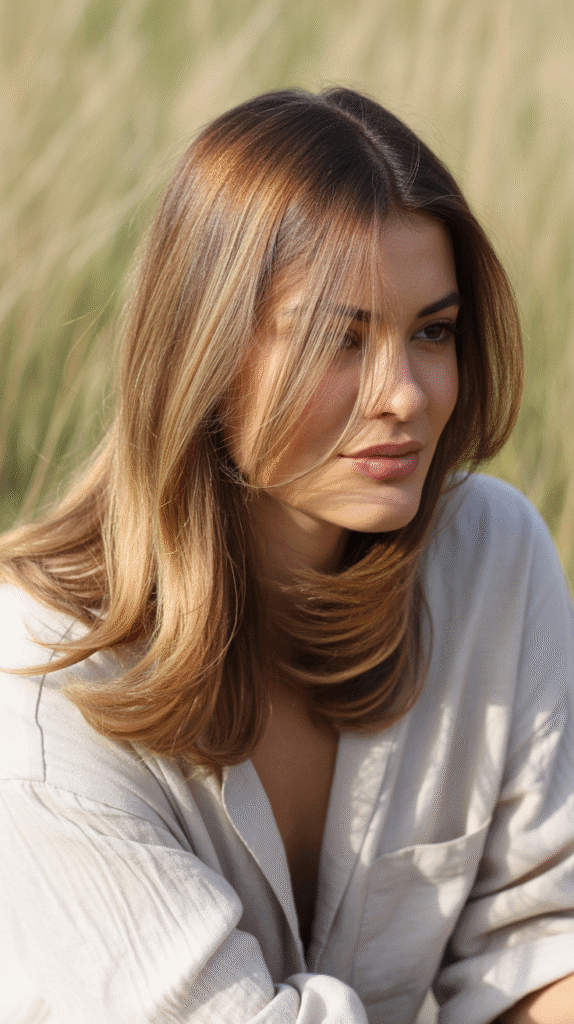
The soft layered cut creates dimension and movement through graduated lengths that frame the face and add body throughout.
This versatile cutting technique works across various hair lengths, from long layers that enhance natural flow to shorter layers that create volume and shape.
- The French approach to layering emphasizes subtlety over drama, with layers blending seamlessly rather than creating obvious steps or chunks that can appear dated or harsh.
- Face-framing layers typically begin around the cheekbone or jaw level, gradually increasing in length as they move back, which creates flattering dimension without sacrificing overall length.
- The cutting technique uses point-cutting or slide-cutting methods that create soft, feathered edges rather than blunt lines, ensuring layers blend beautifully and move naturally.
- This cut enhances natural texture beautifully, making waves appear more dimensional and giving straight hair natural movement without requiring extensive styling.
- Layers strategically placed around the crown area create volume for those with fine or flat hair, adding body where it’s most needed without creating an overly layered appearance throughout.
- Maintenance requires trims every eight to ten weeks to keep layers fresh and prevent the longer pieces from appearing straggly or the shorter pieces from growing out awkwardly.
14. Twisted Low Bun
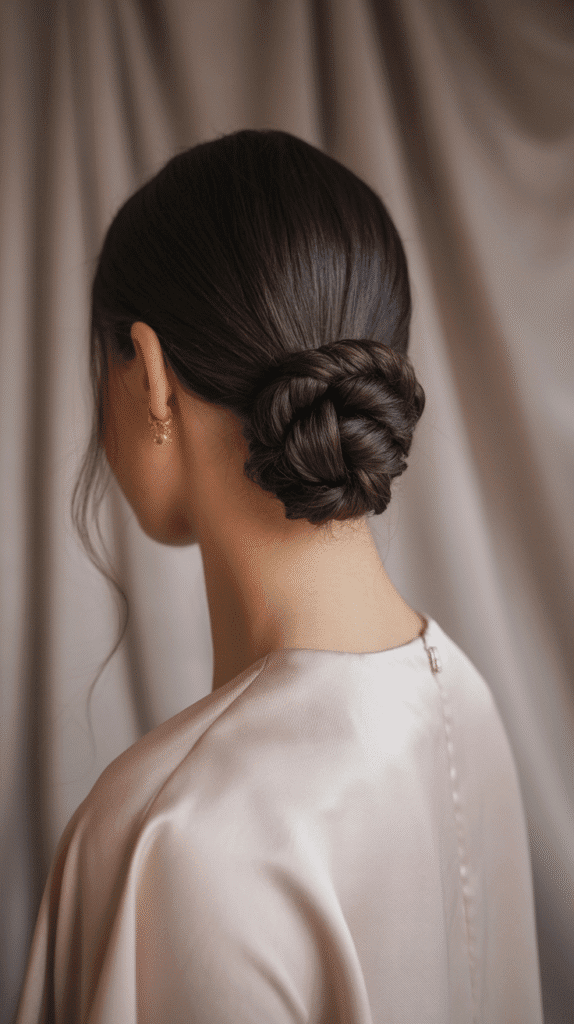
The twisted low bun combines sophistication with subtle texture, gathering hair into a low bun that incorporates twisting techniques for added dimension and visual interest.
This elegant updo offers more complexity than a standard bun while maintaining the understated elegance characteristic of French styling.
- Construction involves dividing hair into two or three sections, twisting each section individually before wrapping them together around the base to create visible texture within the finished bun.
- The twisting technique creates a rope-like appearance that adds dimension and prevents the bun from appearing flat or one-dimensional, even when viewed from various angles.
- Positioning at the nape of the neck creates an elongating effect while maintaining the low, modest placement that characterizes classic French updos.
- Strategic pinning secures the twisted sections individually before wrapping, ensuring each twist maintains its definition and doesn’t unravel during the wrapping process.
- Leaving a few face-framing pieces loose softens the overall look and prevents the style from appearing too severe or controlled, maintaining that essential French undone quality.
- This versatile updo works beautifully for professional settings, formal events, or elegant casual occasions, adapting to various contexts through accessories or slight variations in tightness and finish.
15. Long Center Part
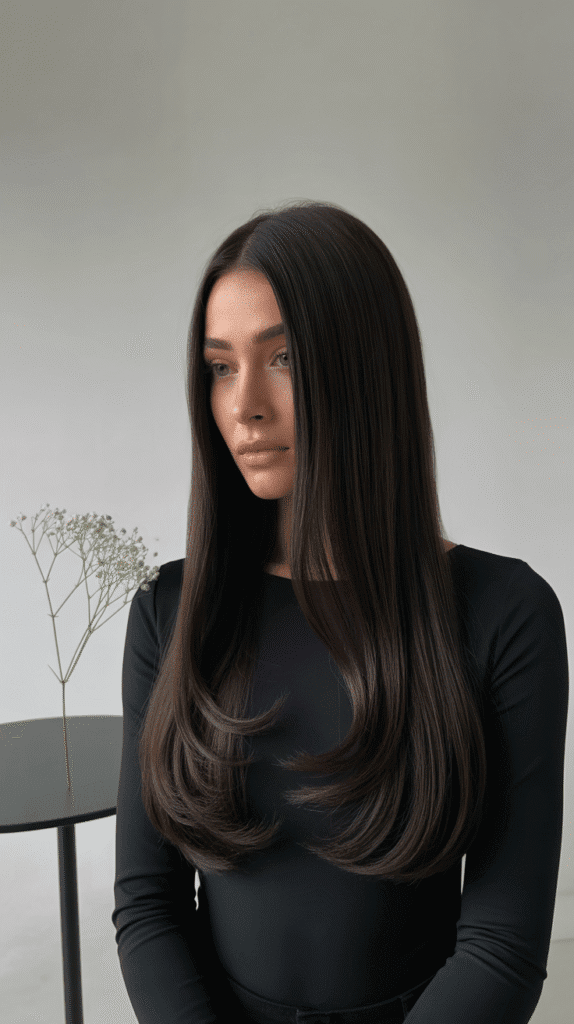
The long center part represents minimalism at its finest, using precise positioning and natural flow to create a timeless, balanced look that emphasizes hair health and natural texture.
This seemingly simple style requires excellent hair condition and strategic maintenance to achieve its effortless appearance.
- The center part creates symmetrical face-framing that emphasizes facial balance and works particularly well for those with oval or heart-shaped face structures.
- Achieving precision requires parting damp hair with a fine-tooth comb from the forehead straight back to the crown, using the comb’s pointed end to create a clean, defined line.
- Hair health becomes immediately apparent with this minimal style, making regular conditioning treatments, minimal heat styling, and protective care essential for maintaining the polished appearance.
- The French interpretation often incorporates slight bends or natural waves through the length rather than perfectly straight hair, which can appear too severe or high-maintenance.
- Maintaining the part’s precision throughout the day requires a light hairspray along the parted line and occasional smoothing with clean fingers to prevent shifting or frizzing.
- This style showcases color beautifully, whether natural single tones or subtle balayage, as the length and simplicity provide maximum visibility for color dimension and shine.
16. Braided Side Ponytail
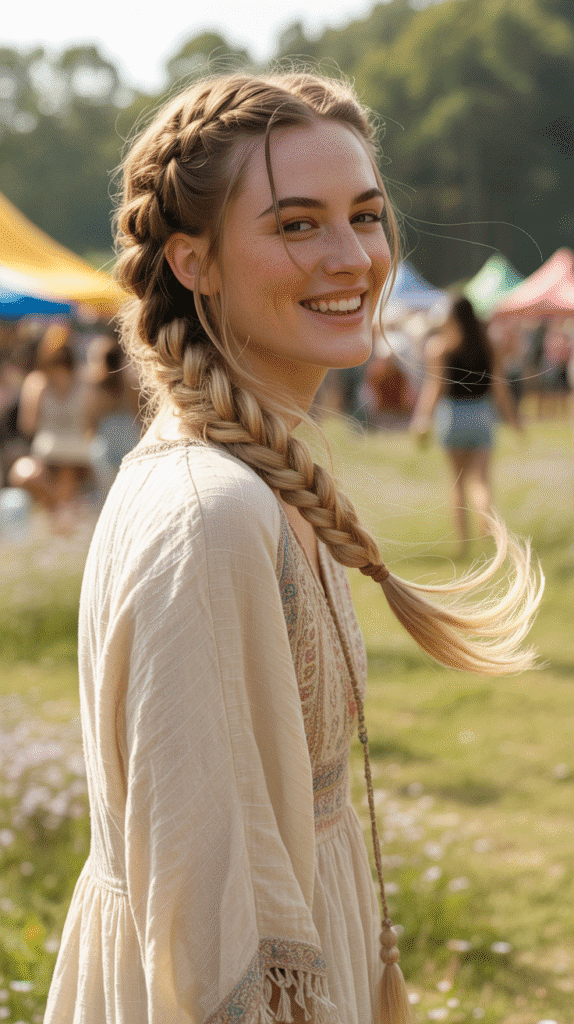
The braided side ponytail combines playful asymmetry with textured detailing, gathering hair into a low side ponytail that incorporates braiding for added visual interest and romantic appeal.
This style balances casual ease with considered detail, making it suitable for various occasions.
- The positioning sits low on one side of the neck rather than directly at the nape, creating an asymmetrical appearance that adds interest without appearing off-balance.
- Braiding can be incorporated various ways—braiding the ponytail itself, including a braid within the side ponytail, or creating small braids that feed into the side ponytail gathering point.
- The French approach maintains looseness throughout, with the ponytail secured gently and any braids deliberately relaxed and “pancaked” to create width and a softer appearance.
- Face-framing pieces on the opposite side of the ponytail balance the asymmetry and prevent the style from appearing too heavily weighted to one side.
- Texture throughout the ponytail enhances the casual, romantic quality—waves, bends, or natural curl work beautifully, while perfectly straight hair can appear too controlled for this deliberately relaxed style.
- This versatile look transitions easily from day to evening by adjusting accessories, adding flowers or ribbons for bohemian occasions or keeping it simple with a subtle hair tie for daily wear.
17. Wispy Fringe
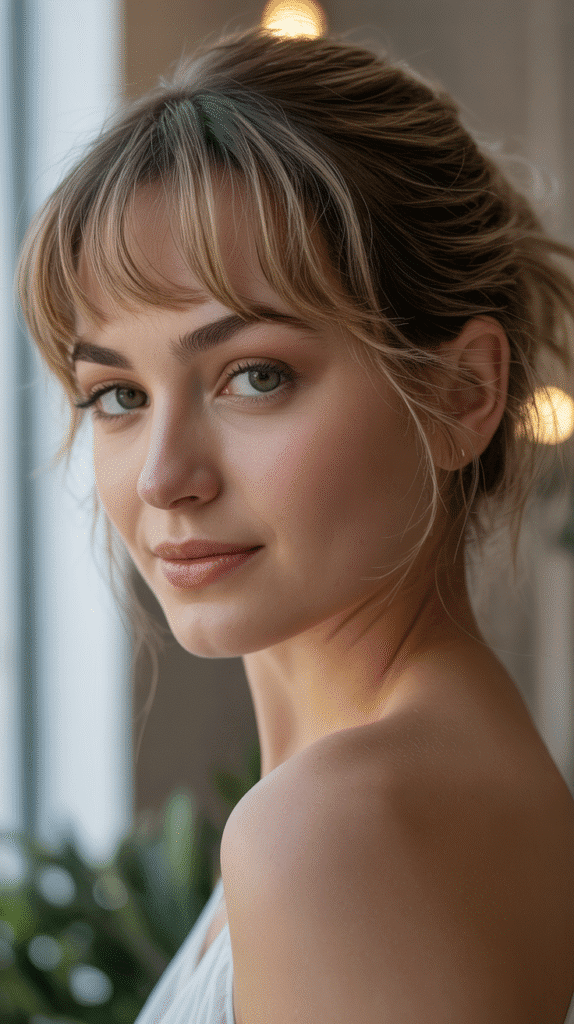
Wispy fringe creates a soft, barely-there bang that grazes the forehead with delicate pieces rather than forming a solid curtain of hair.
This subtle approach to bangs adds face-framing dimension while maintaining an airy, light quality that never appears heavy or overwhelming.
- The cutting technique uses point-cutting with scissors held vertically to create feathered, irregular ends that vary slightly in length, preventing any harsh horizontal line.
- Wispy fringe typically features relatively sparse hair compared to full bangs, using fewer sections from the crown area to maintain the light, see-through quality that defines this style.
- Styling involves blow-drying fringe forward with a round brush, then using fingers to separate and arrange individual pieces rather than leaving them as a solid unit.
- This bang style proves remarkably versatile for growing out, as the wispy nature means no awkward blunt-growing-out phase—pieces simply blend into face-framing layers as they lengthen.
- The light, separated quality works beautifully for fine hair textures that might look overwhelmed by heavier, fuller bang styles, adding dimension without creating heaviness.
- Maintenance requires trims every four to six weeks to maintain the optimal length and feathered texture, though the forgiving nature means growing out slightly between trims doesn’t create major styling issues.
18. Rolled Edges Bob
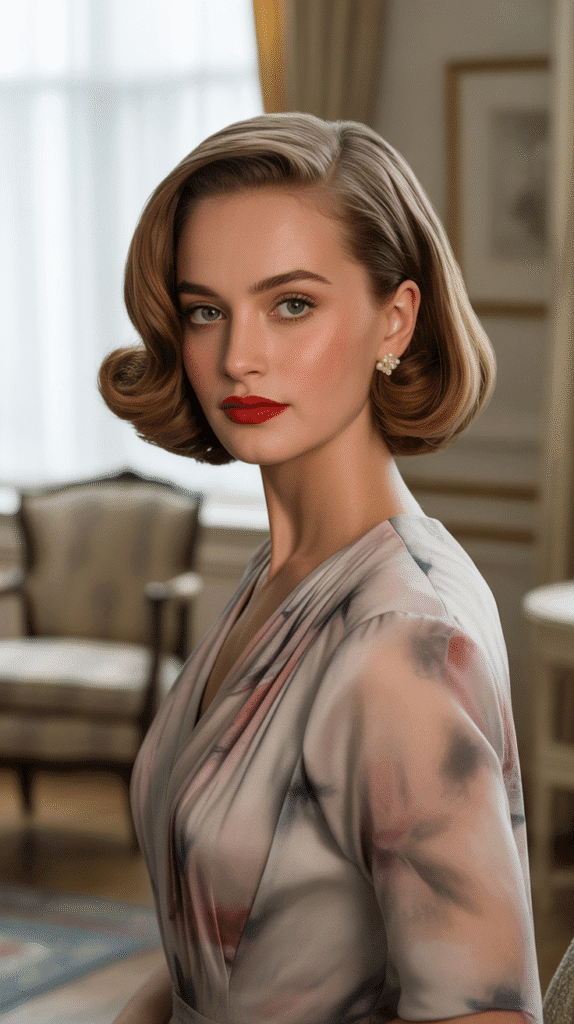
The rolled edges bob updates the classic bob silhouette by curling the ends under in a gentle roll that creates rounded smoothness and polished sophistication.
This vintage-inspired technique adds softness while maintaining the bob’s characteristic structure and clean lines.
- Creating the rolled edges requires blow-drying with a round brush, rolling hair inward as it dries to create the signature curved-under finish that distinguishes this from straight-ended bobs.
- The roll should be subtle rather than dramatic, creating a gentle curve that adds polish without appearing overly styled or creating the tight, set appearance of vintage roller sets.
- This technique works particularly well for medium-density hair, as too-fine hair may not hold the curl while very thick hair might create too much bulk at the ends.
- The smooth top and sides provide contrast with the rolled ends, requiring careful blow-drying technique that maintains sleekness through the lengths while building the roll at the tips.
- For lasting hold, wrapping the dried, rolled sections around large velcro rollers while they cool sets the shape, which is then gently brushed to create smooth, rounded edges.
- A light finishing spray applied to the rolled ends helps maintain the curve throughout the day without creating stiffness or reducing the hair’s natural movement and touchability.
19. Loose Fishtail Braid
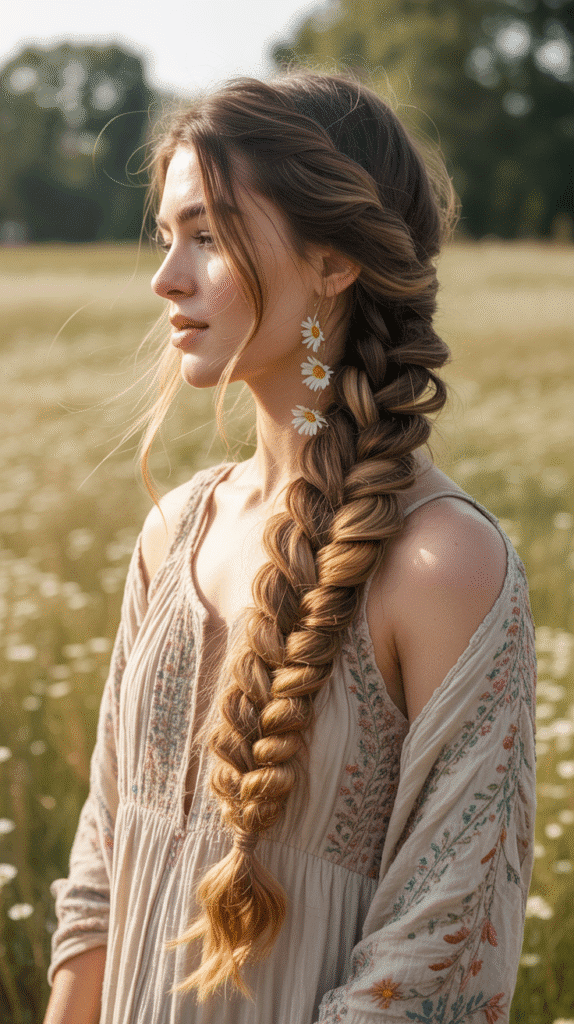
The loose fishtail braid creates intricate texture through an alternating weaving pattern that appears complex while maintaining the deliberately imperfect, relaxed quality essential to French styling.
This detailed braiding technique adds visual interest while keeping the overall effect soft and romantic.
- The fishtail pattern involves dividing hair into two sections and repeatedly pulling small pieces from the outer edge of one section over to join the other section, creating the characteristic herringbone appearance.
- The French interpretation keeps sections relatively large and loosely tensioned, preventing the tight, precise appearance of structured fishtail braids in favor of relaxed, organic texture.
- After completing the braid, gently pulling apart the woven sections—particularly along the outer edges—increases width dramatically and creates the soft, dimensional quality that prevents the style from appearing too structured.
- Starting the braid lower, at the nape or even mid-length rather than at the crown, maintains volume at the roots and prevents the overall look from appearing flat or too controlled.
- This versatile braid works beautifully for various occasions, dressing up or down depending on how loosely it’s pulled apart and whether accessories like ribbons or flowers are incorporated.
- The fishtail pattern showcases highlights and balayage coloring beautifully, as the woven texture creates natural opportunities for lighter pieces to show through and add dimension.
20. Tucked Behind Ears
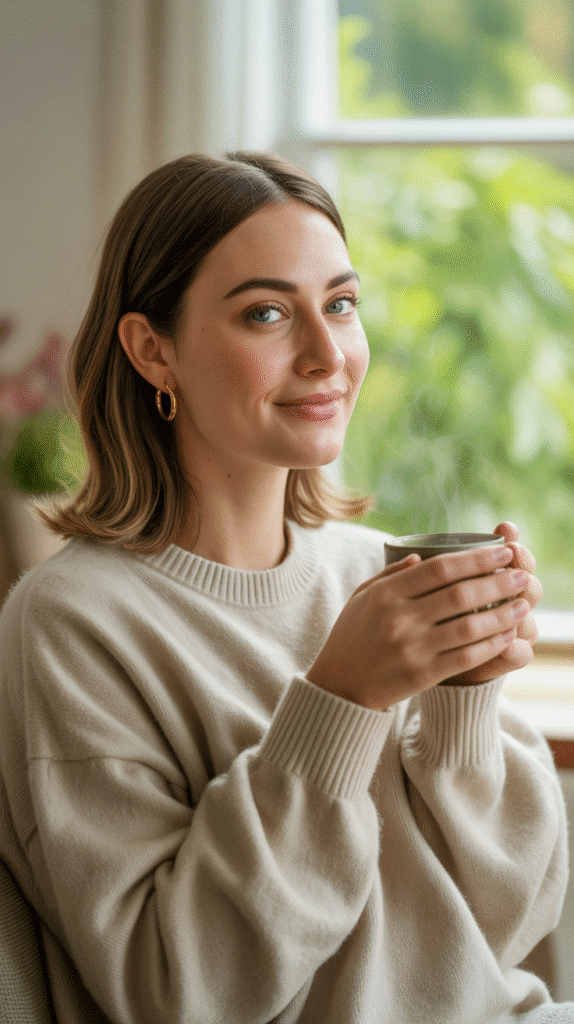
The tucked behind ears style exemplifies minimalist chic, using this simple gesture to create an asymmetrical look that keeps hair off the face while maintaining natural flow and movement.
This effortless technique demonstrates how the smallest adjustments create maximum style impact.
- The French approach typically tucks hair behind both ears rather than just one, creating a clean, open frame for the face that emphasizes facial features and jewelry.
- This style works best with hair that has natural body or slight wave, as completely straight hair may not stay tucked as easily and can appear flat against the head.
- Strategic bobby pin placement just behind the ear, hidden within the tucked section, provides security for longer hair while maintaining the appearance that hair naturally stays in place.
- The tucked sections should appear smooth and intentional rather than messy, requiring a quick smoothing with fingers or a brush before tucking to eliminate any bumps or flyaways.
- This minimal styling technique showcases earrings beautifully, making it perfect for highlighting statement earrings or delicate ear jewelry that might otherwise be hidden.
- The back and opposite side maintain natural volume and movement, preventing the overall style from appearing too flat or severe despite the tucked front sections.
21. Voluminous Blowout
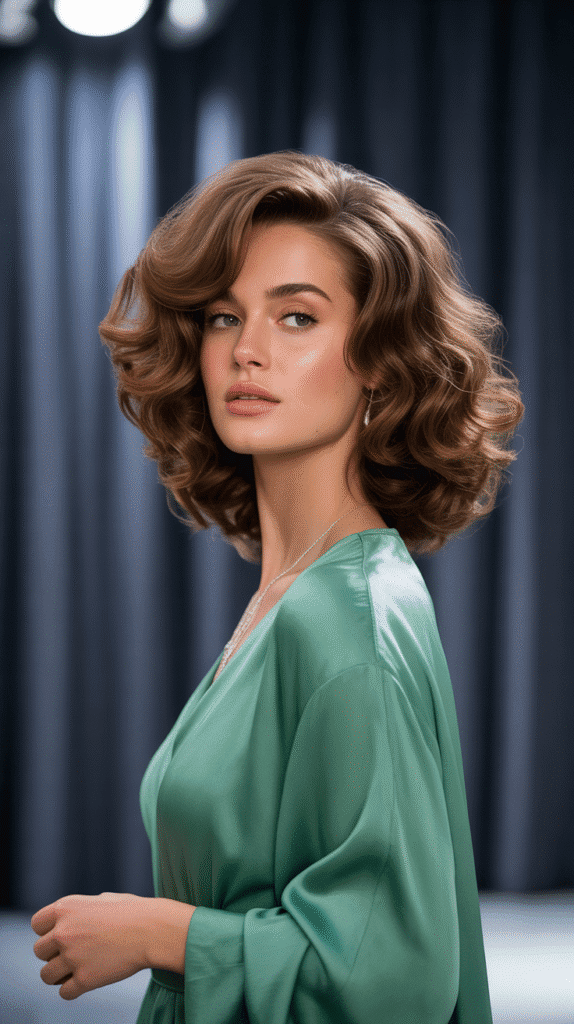
The voluminous blowout creates bouncy fullness through precise blow-drying techniques that maximize body and movement while maintaining a smooth, polished finish.
This salon-worthy style brings glamorous volume to everyday styling, proving that French effortlessness can include intentional polish when desired.
- The technique begins with applying volumizing mousse or spray to damp roots, then blow-drying hair in sections while lifting at the roots to create maximum lift and body.
- Using a round brush with hair wrapped around the barrel while directing heat from the dryer creates smooth sections with curled ends that add to the overall bouncy appearance.
- The French interpretation keeps volume looking natural rather than teased or artificially inflated, focusing on creating movement and body throughout rather than extreme height at the crown.
- Sectioning proves crucial—working in manageable sections ensures each area receives proper attention and drying technique, preventing some sections from appearing flat while others have volume.
- The finishing technique involves allowing hair to cool completely in its styled shape before running fingers through gently, which maintains volume while preventing the stiffness of traditional set styles.
- A light, flexible-hold hairspray applied from underneath at the roots helps maintain volume throughout the day without creating crunchiness or reducing the hair’s natural movement.
22. Scarf-Wrapped Ponytail
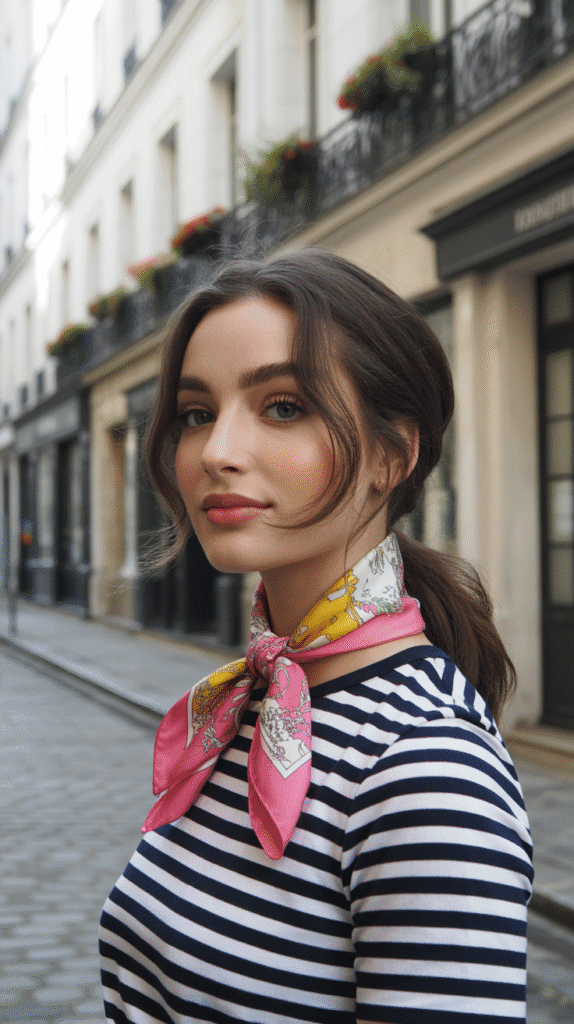
The scarf-wrapped ponytail incorporates fabric accessories into a classic ponytail structure, adding color, pattern, and textural interest while maintaining practical functionality.
This style combines French love of accessories with timeless hair placement, creating looks that range from casual to elegant depending on scarf choice.
- The scarf can be incorporated various ways—wrapped around the ponytail length, tied around the elastic securing point, or woven through the ponytail itself for distributed color and pattern.
- Silk or satin scarves provide the most elegant finish and create less friction against hair compared to cotton materials, preventing frizz while adding luxurious sheen.
- Securing the ponytail first with a simple elastic, then adding the scarf afterward, ensures proper hold from the hair tie while using the scarf purely for decorative enhancement.
- The French approach typically uses smaller, narrower scarves rather than large squares, creating delicate accent rather than overwhelming the hairstyle with excessive fabric.
- Pattern and color selection allows for endless variation—classic French patterns like stripes or small geometric prints maintain sophistication while bold colors or florals create more playful looks.
- The scarf ends can be left hanging for movement and visual interest or tied in a small bow for controlled, polished finishing, depending on the desired level of formality.
23. Barely-There Highlights
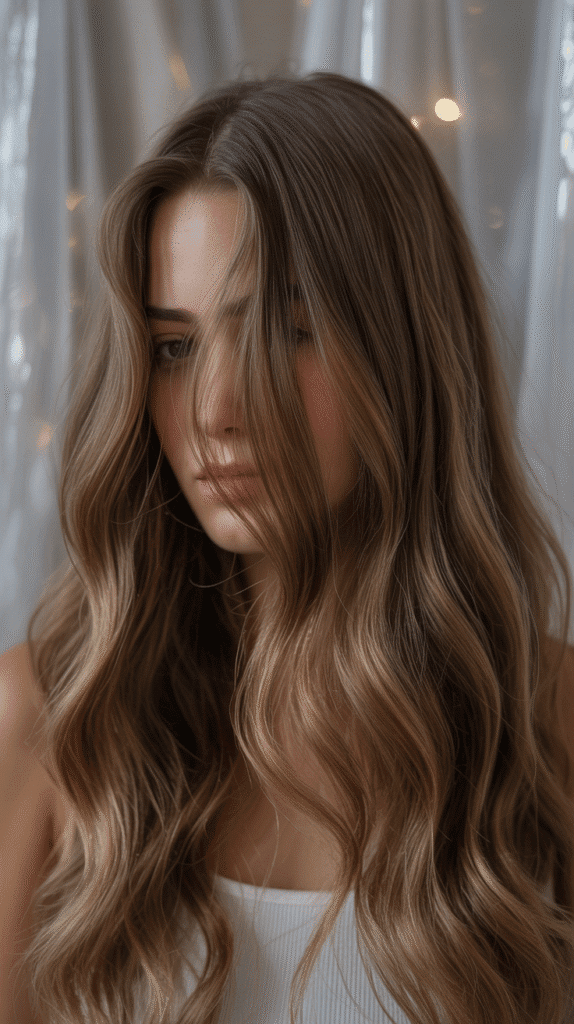
Barely-there highlights represent the French approach to hair coloring, using subtle lightening that mimics natural sun-lightening rather than creating obvious, contrasting color placement.
This nuanced coloring technique adds dimension and brightness while maintaining the appearance of naturally beautiful hair.
- The placement focuses on face-framing sections and the surface layer, where sun would naturally lighten hair, creating authentic-looking dimension rather than uniform coloring throughout.
- Color selection stays within one to two shades of the natural base color, preventing dramatic contrast while adding just enough lightness to create movement and depth.
- The application technique uses fine weaving or baby lights—very thin sections of hair lightened—which creates soft, blended results without obvious lines or chunks of color.
- French colorists often place highlights only through the mid-lengths and ends, leaving roots completely natural to eliminate the need for frequent touch-ups and maintenance.
- This subtle approach works beautifully across all base colors, from adding honey tones to light brown hair to creating caramel dimension in darker brunettes.
- The low-maintenance nature aligns perfectly with French beauty philosophy, allowing months between color appointments while always appearing intentional and fresh rather than grown-out or neglected.
24. Pinned Back Waves
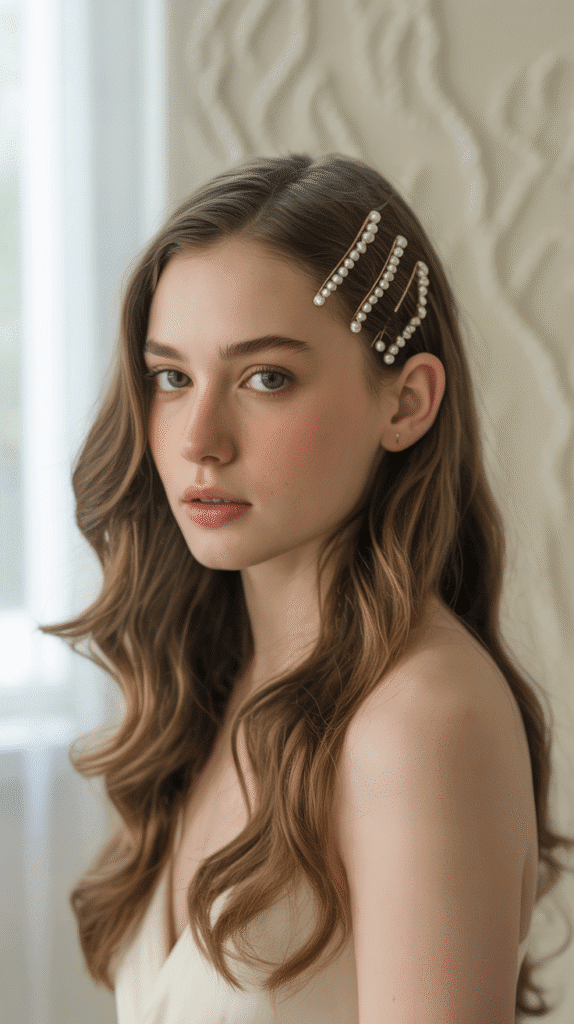
Pinned back waves combine romantic texture with practical face-framing, securing one or both sides away from the face with strategic pinning while allowing the remaining hair to cascade in soft waves.
This hybrid style offers the best of both secured and flowing hair styling.Retry
J
ContinueEdit
- The pinning typically secures hair from the temple backward, using multiple bobby pins arranged in a decorative pattern or a single statement hair clip that becomes a design element itself.
- Creating the waves before pinning ensures consistent texture throughout, using a curling iron or wand to create loose, irregular waves that maintain movement and softness.
- The French approach keeps pinning minimal and purposeful—just enough to secure hair away from the face without creating the appearance of an overly constructed or fussy style.
- Bobby pins can be arranged in geometric patterns, crisscrossed for visual interest, or kept simple and hidden, depending on whether the pins themselves contribute to the overall aesthetic.
- This style works beautifully for various face shapes, with the pinning side customizable based on individual preferences for asymmetry and which features to emphasize or soften.
- The unpinned section maintains full volume and natural fall, creating balance with the secured side while ensuring the overall look doesn’t appear too controlled or one-dimensional.
- For extended wear, a light texturizing spray on the waves and hairspray on the pinned section provides hold without stiffness, maintaining the style’s romantic, touchable quality throughout the day.
25. Graduated Bob with Movement
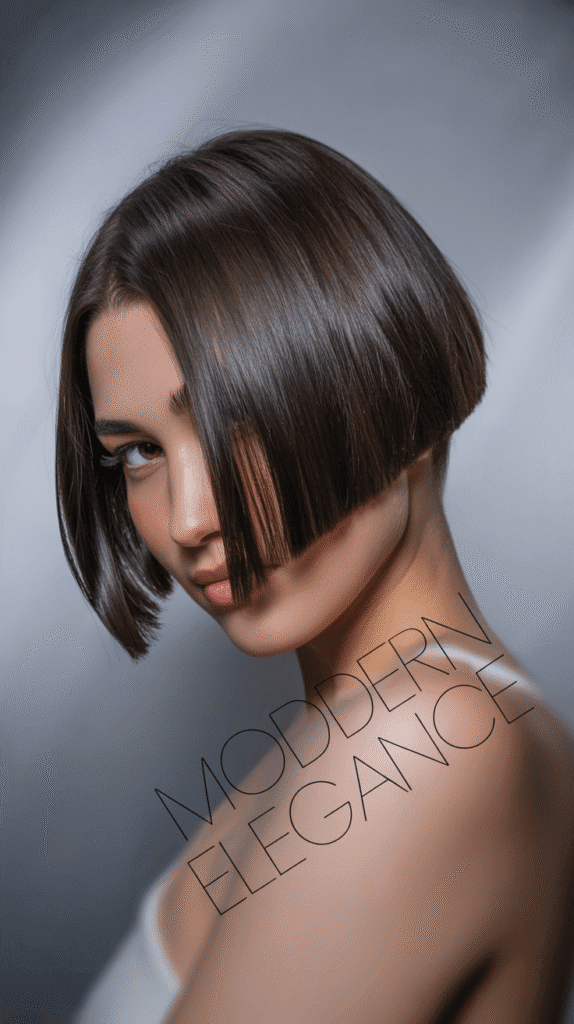
The graduated bob features shorter layers at the back that gradually lengthen toward the front, creating an angled silhouette that emphasizes facial features while adding dynamic movement and dimension.
This architectural cut combines precision with natural flow for a contemporary take on classic bob styling.
- The cutting technique creates a stacked effect at the back, where shorter layers build volume and shape, while the front pieces maintain longer length that frames the face beautifully.
- This graduated structure naturally creates movement and body without requiring extensive styling, as the varied lengths prevent hair from lying flat against the head.
- The angle from back to front should be subtle rather than extreme, creating gentle gradation that appears sophisticated rather than dramatically geometric or dated.
- Styling emphasizes the natural movement created by the cut, typically involving blow-drying smooth with slight bending at the ends rather than adding curls or waves that might obscure the cut’s architecture.
- This cut works particularly well for fine to medium hair textures, as the layering creates the illusion of thickness and body while the graduated shape adds dimension.
- Maintenance requires regular trims every six to eight weeks to maintain the precise graduation and prevent the back from becoming too short or the front pieces from extending beyond the intended length.
- The French interpretation keeps the overall appearance polished but not severe, often incorporating slight texture at the ends or face-framing softness that prevents the geometric cut from appearing too rigid.
26. Natural Texture Embrace
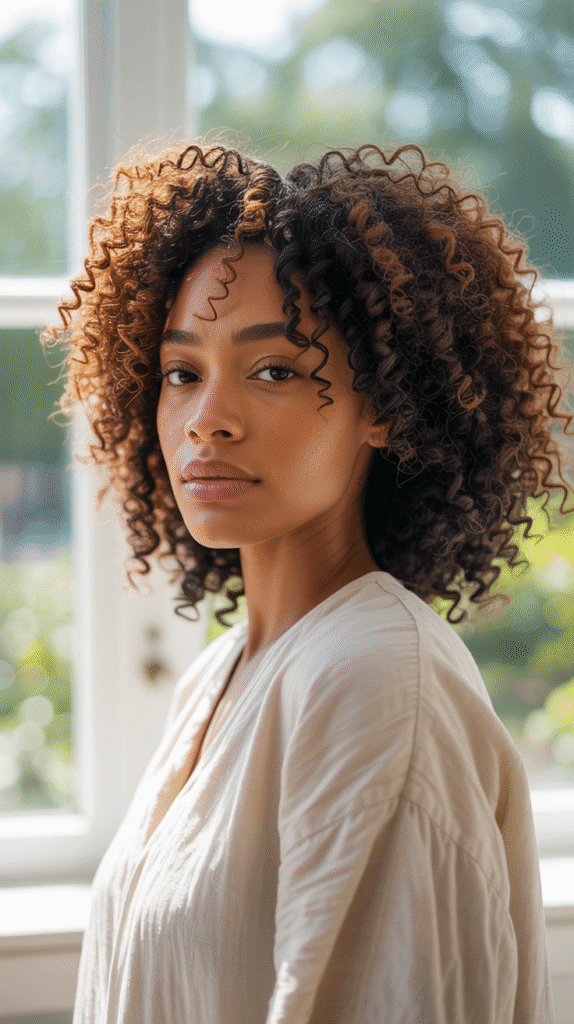
Natural texture embrace represents the ultimate French hair philosophy—working with your hair’s inherent characteristics rather than against them, celebrating curls, waves, or straight strands in their authentic form.
This approach prioritizes hair health and authenticity over conforming to any particular style standard.
- The foundation involves identifying your hair’s natural pattern and moisture needs, then selecting products and techniques that enhance rather than fight these inherent characteristics.
- For naturally wavy hair, this means embracing irregular wave patterns rather than forcing uniform curls or straightening completely, using light styling products that define without weighing down.
- Curly hair benefits from moisture-rich products and techniques like plopping or diffusing that enhance curl definition while minimizing frizz without requiring heat styling or manipulation.
- Those with naturally straight hair can celebrate the sleekness and shine that comes with this texture rather than constantly adding waves or curls that require heat and products.
- The French approach to natural texture involves minimal heat styling, focusing instead on air-drying techniques and products that work with the hair’s natural inclinations.
- Regular trims maintain hair health regardless of texture, removing damaged ends that can make any hair type appear less healthy and vibrant than its natural potential.
- This philosophy extends to color as well, with many French women choosing to embrace their natural color or using subtle enhancements rather than dramatic transformations that require extensive maintenance.
27. Elegant Low Waves
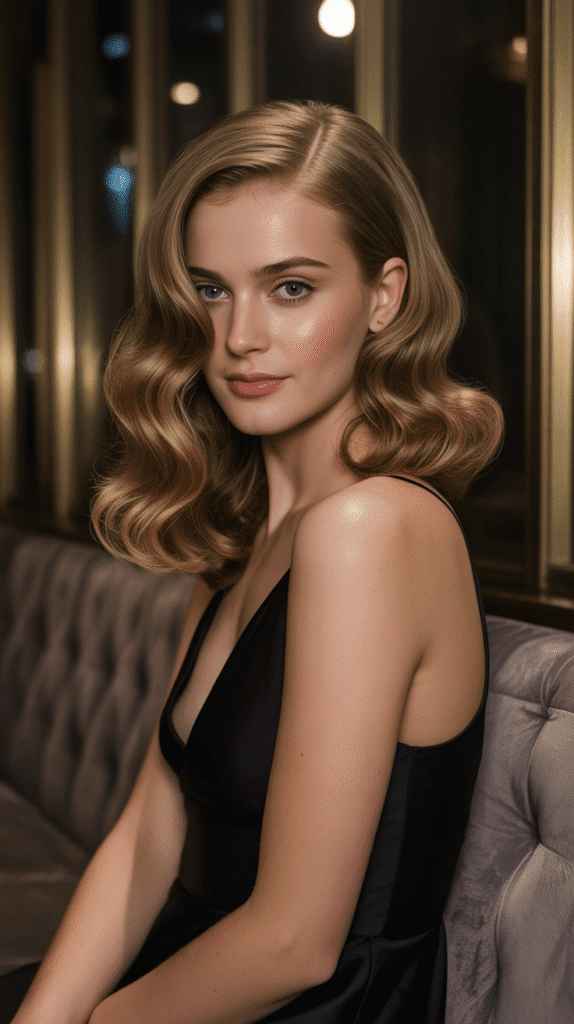
Elegant low waves create sophisticated movement positioned primarily from mid-lengths to ends, keeping roots relatively smooth while allowing gentle, uniform waves to add dimension and polish.
This refined style strikes the perfect balance between structured and relaxed, offering enough definition to appear intentional while maintaining natural softness.
- The wave placement begins around ear level or slightly below, maintaining smoothness through the crown and upper sections that prevents the style from appearing overly textured or messy.
- Creating these waves requires a large-barrel curling iron or wand, wrapping hair sections uniformly in the same direction to create consistent wave patterns throughout.
- The French technique involves allowing each curled section to cool completely before releasing, then gently brushing through all waves together with a natural bristle brush to create uniformity and softness.
- Unlike beachy waves that celebrate irregularity, elegant low waves maintain consistent size and pattern, creating a more polished appearance suitable for formal or professional settings.
- The smooth root area can be enhanced with a light smoothing serum or cream that adds shine and controls any frizz or flyaways, emphasizing the intentional contrast between smooth and waved sections.
- This versatile style transitions beautifully from office to evening events, requiring minimal touch-ups beyond perhaps refreshing a few waves with a curling iron or adding a light mist of hairspray.
- The overall effect communicates refined sophistication while maintaining the approachable, touchable quality that prevents French styling from ever appearing too precious or untouchable.
Conclusion
The enduring appeal of 27 Trendy French Hairstyles That Define Effortless Chic lies not just in the specific techniques or cuts themselves, but in the philosophy they represent—a celebration of natural beauty enhanced rather than hidden, of confidence expressed through subtle refinement rather than dramatic transformation.
From the architectural precision of the classic French bob to the romantic softness of loose braided crowns, these styles demonstrate that true elegance comes from working with your hair’s inherent qualities rather than against them.
Whether you’re drawn to the minimalist sophistication of a sleek low ponytail or the textured dimension of barely-there highlights, the French approach offers something for every hair type, length, and personal style preference.
The secret to successfully adopting these looks lies in embracing imperfection, prioritizing hair health, and understanding that the most captivating hairstyle is one that makes you feel authentically yourself.
As you explore these twenty-seven styles, remember that French beauty isn’t about rigid rules or perfect execution—it’s about cultivating a personal aesthetic that appears effortless precisely because it honors who you naturally are rather than who you think you should be.Retry
